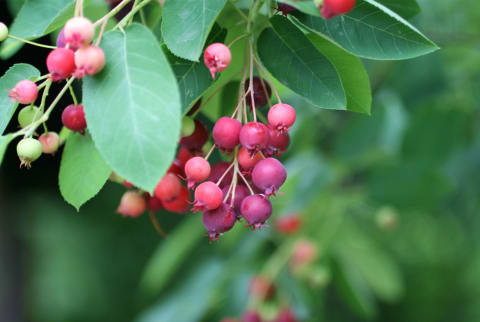Advertisement
How To Start A Wildlife-Friendly Edible Garden: Plants To Start With & Tips


Your yard isn't yours alone; it's a space you share with local wildlife. That means that when choosing plants, it's important to go beyond aesthetics and look for ones that also create a comfortable habitat for the animals and insects in your area.
Nancy Lawson, naturalist and author of The Humane Gardener: Nurturing a Backyard Habitat for Wildlife, says that planting a variety of different species is one cornerstone of a wildlife-friendly garden. "If you have a lot of plants for all the animals, it takes the pressure off any one particular food source," she tells me from her home garden in central Maryland, over the chatter of busy birds in the background.
Wildlife-friendly edible plants to add to your garden:
- Ramps: These fragrant, garlicky wild leeks are often foraged from forests. When cultivating them in your own garden, you can just clip the leaves and allow the bulbs to stay in the ground to regrow and provide shade and habitat.
- Pawpaw trees: Home of the largest edible fruit native to North America, which tastes like a cross between a banana and a mango, Pawpaw trees are small and relatively easy to care for. "They are host plants for the zebra swallowtail butterfly," Lawson says, "and the fruits are also eaten by mammals."
- Brambles: Brambles—fruits in the raspberry and blackberry families—are great for both people and wildlife. "Birds can nest in them and deer eat them, but they don't eat them to the ground," Lawson says, leaving plenty of fruit left for us to cultivate for jams and desserts. In her garden, you'll find black raspberries, Allegheny blackberries, and chokeberries.
Note that these plants thrive in the Maryland region. If you live outside the Northeast, you can check in with the Audubon's Native Plant Database, Lady Bird Johnson's Wildflower Finder, or your state's Native Plant Society for ideas, too. Visiting your nearby parks or natural areas and identifying the species growing there (the iNaturalist app can help) can also provide inspiration for your edible oasis.
How to plant them:
- Place them close together: Lawson sees many gardeners leaving a lot of space between their plants, shrubs, and trees and covering it up with mulch. "When you do that, you're depriving ground-nesting bees, which make up most of our native bee species, of nesting sites," she says. To make room for these essential pollinators (which don't usually sting, by the way), you can place plants closer together and use ground cover plants and flowers instead of mulch.
- Let them take over your lawn: Wildlife is always looking for food and shelter. A pristinely mowed lawn has neither, so Lawson recommends keeping your lawn as small as possible. Use that valuable outdoor space for plants instead. If you have a larger yard, you can start small by replacing one patch at a time.
- Let a little decay happen: Planting a wildlife-friendly garden requires a touch of surrender. The more that we exert control over our environment, the further it gets from its wild and natural state. "Plants have been growing for hundreds of millions of years, most of that time without us," Lawson says. Once you get your plants in the ground, consider that permission to let nature take its course. Try out lazy gardening techniques like allowing fallen leaves to decay on the ground, as they'll ultimately provide more nutrients to the soil and places for critters to rest. Everything in nature happens for a reason; we just need to trust it.
The takeaway
Filling your garden with wildlife-friendly edible plants will attract critters of all kinds. You may love some more than others, but remember that they're all essential to a vibrant ecosystem. "You can't have birds without having caterpillars and earthworms and all these other creatures that feed them," Lawson reminds us. "We're all in this world together."